Organisational Behaviour Report: Tesco's Culture, Politics, Power
VerifiedAdded on 2020/07/22
|18
|5438
|151
Report
AI Summary
This report provides a comprehensive analysis of organisational behaviour within Tesco. It examines the influence of organisational culture, politics, and power on individual and team performance, utilising Handy's cultural classifications to illustrate these impacts. The report further explores content and process theories of motivation, including Maslow's hierarchy, Alderfer's ERG theory, Herzberg's two-factor theory, and Vroom's expectancy theory, alongside motivational techniques to achieve business goals. It then differentiates between effective and ineffective teams, supported by relevant team and group development theories. Finally, the report concludes with an overview of organisational behaviour concepts and philosophies and their positive and negative effects within the Tesco firm.
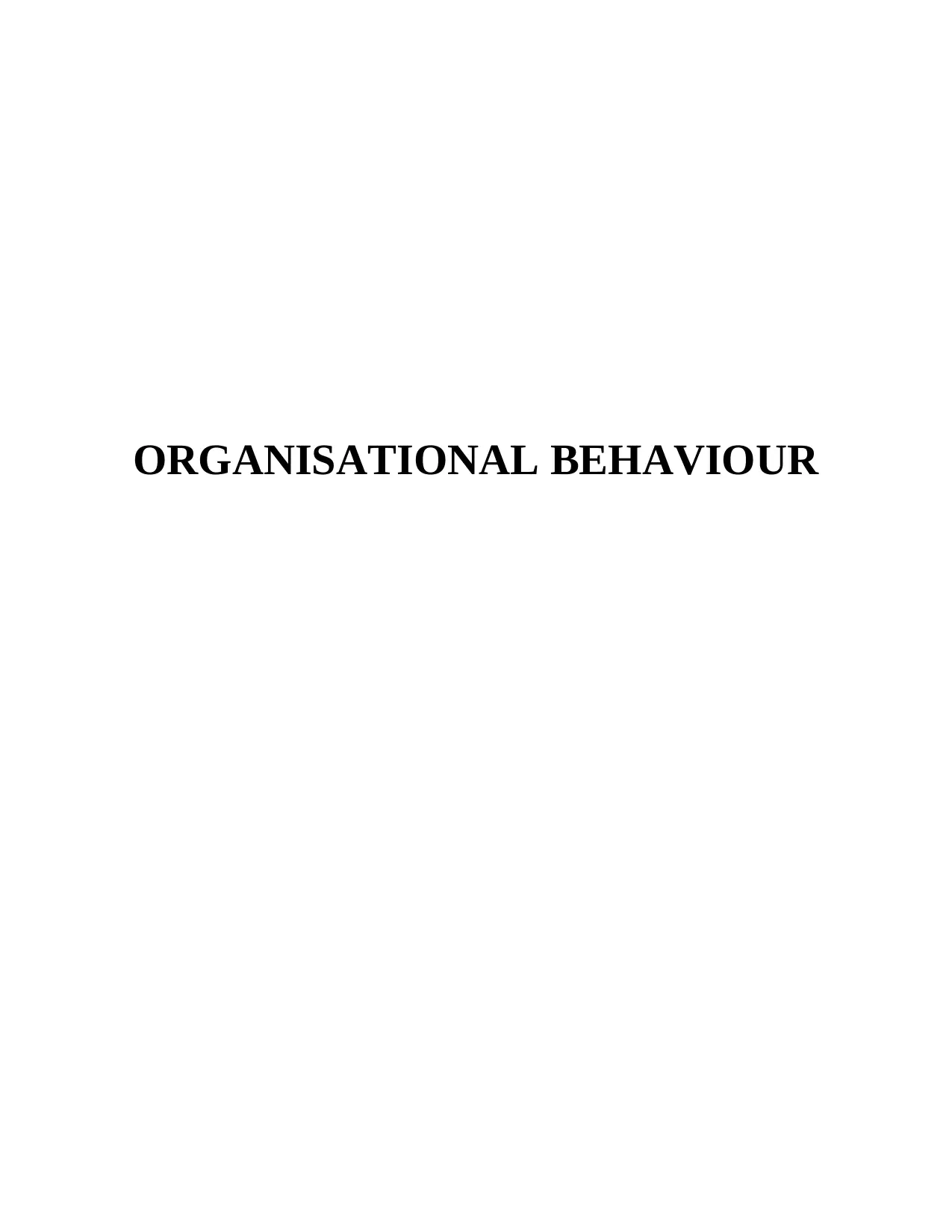
ORGANISATIONAL BEHAVIOUR
Paraphrase This Document
Need a fresh take? Get an instant paraphrase of this document with our AI Paraphraser
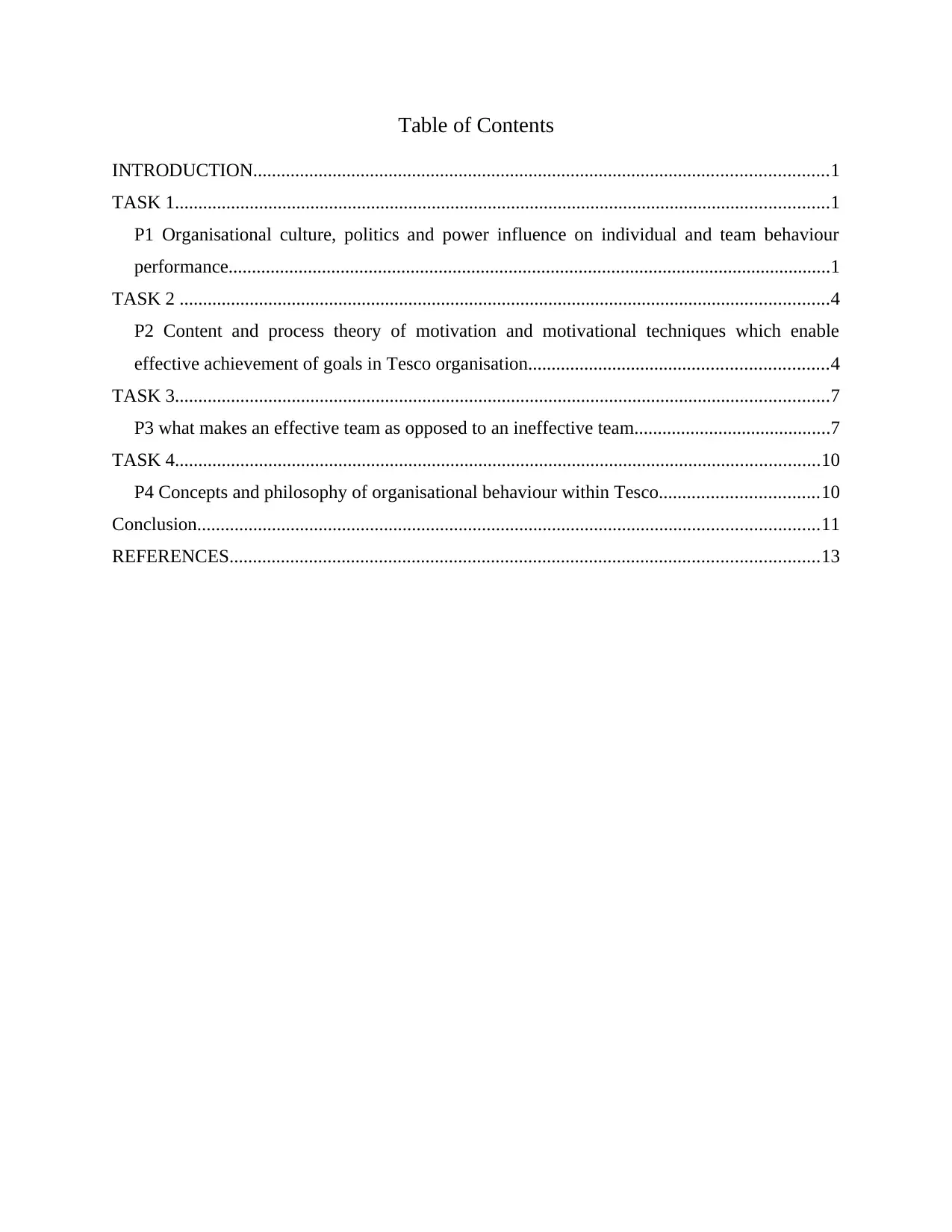
Table of Contents
INTRODUCTION...........................................................................................................................1
TASK 1............................................................................................................................................1
P1 Organisational culture, politics and power influence on individual and team behaviour
performance.................................................................................................................................1
TASK 2 ...........................................................................................................................................4
P2 Content and process theory of motivation and motivational techniques which enable
effective achievement of goals in Tesco organisation................................................................4
TASK 3............................................................................................................................................7
P3 what makes an effective team as opposed to an ineffective team..........................................7
TASK 4..........................................................................................................................................10
P4 Concepts and philosophy of organisational behaviour within Tesco..................................10
Conclusion.....................................................................................................................................11
REFERENCES..............................................................................................................................13
INTRODUCTION...........................................................................................................................1
TASK 1............................................................................................................................................1
P1 Organisational culture, politics and power influence on individual and team behaviour
performance.................................................................................................................................1
TASK 2 ...........................................................................................................................................4
P2 Content and process theory of motivation and motivational techniques which enable
effective achievement of goals in Tesco organisation................................................................4
TASK 3............................................................................................................................................7
P3 what makes an effective team as opposed to an ineffective team..........................................7
TASK 4..........................................................................................................................................10
P4 Concepts and philosophy of organisational behaviour within Tesco..................................10
Conclusion.....................................................................................................................................11
REFERENCES..............................................................................................................................13
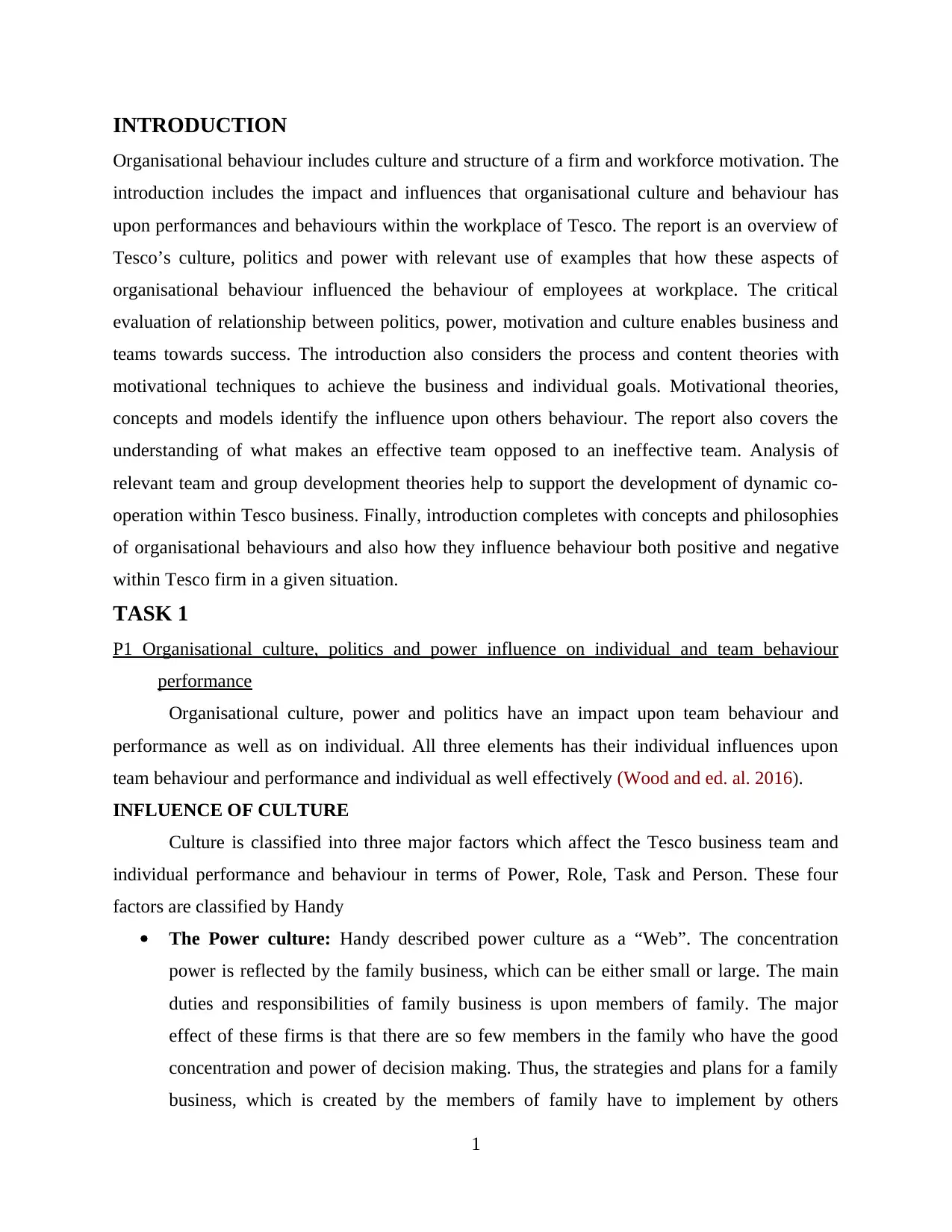
INTRODUCTION
Organisational behaviour includes culture and structure of a firm and workforce motivation. The
introduction includes the impact and influences that organisational culture and behaviour has
upon performances and behaviours within the workplace of Tesco. The report is an overview of
Tesco’s culture, politics and power with relevant use of examples that how these aspects of
organisational behaviour influenced the behaviour of employees at workplace. The critical
evaluation of relationship between politics, power, motivation and culture enables business and
teams towards success. The introduction also considers the process and content theories with
motivational techniques to achieve the business and individual goals. Motivational theories,
concepts and models identify the influence upon others behaviour. The report also covers the
understanding of what makes an effective team opposed to an ineffective team. Analysis of
relevant team and group development theories help to support the development of dynamic co-
operation within Tesco business. Finally, introduction completes with concepts and philosophies
of organisational behaviours and also how they influence behaviour both positive and negative
within Tesco firm in a given situation.
TASK 1
P1 Organisational culture, politics and power influence on individual and team behaviour
performance
Organisational culture, power and politics have an impact upon team behaviour and
performance as well as on individual. All three elements has their individual influences upon
team behaviour and performance and individual as well effectively (Wood and ed. al. 2016).
INFLUENCE OF CULTURE
Culture is classified into three major factors which affect the Tesco business team and
individual performance and behaviour in terms of Power, Role, Task and Person. These four
factors are classified by Handy
The Power culture: Handy described power culture as a “Web”. The concentration
power is reflected by the family business, which can be either small or large. The main
duties and responsibilities of family business is upon members of family. The major
effect of these firms is that there are so few members in the family who have the good
concentration and power of decision making. Thus, the strategies and plans for a family
business, which is created by the members of family have to implement by others
1
Organisational behaviour includes culture and structure of a firm and workforce motivation. The
introduction includes the impact and influences that organisational culture and behaviour has
upon performances and behaviours within the workplace of Tesco. The report is an overview of
Tesco’s culture, politics and power with relevant use of examples that how these aspects of
organisational behaviour influenced the behaviour of employees at workplace. The critical
evaluation of relationship between politics, power, motivation and culture enables business and
teams towards success. The introduction also considers the process and content theories with
motivational techniques to achieve the business and individual goals. Motivational theories,
concepts and models identify the influence upon others behaviour. The report also covers the
understanding of what makes an effective team opposed to an ineffective team. Analysis of
relevant team and group development theories help to support the development of dynamic co-
operation within Tesco business. Finally, introduction completes with concepts and philosophies
of organisational behaviours and also how they influence behaviour both positive and negative
within Tesco firm in a given situation.
TASK 1
P1 Organisational culture, politics and power influence on individual and team behaviour
performance
Organisational culture, power and politics have an impact upon team behaviour and
performance as well as on individual. All three elements has their individual influences upon
team behaviour and performance and individual as well effectively (Wood and ed. al. 2016).
INFLUENCE OF CULTURE
Culture is classified into three major factors which affect the Tesco business team and
individual performance and behaviour in terms of Power, Role, Task and Person. These four
factors are classified by Handy
The Power culture: Handy described power culture as a “Web”. The concentration
power is reflected by the family business, which can be either small or large. The main
duties and responsibilities of family business is upon members of family. The major
effect of these firms is that there are so few members in the family who have the good
concentration and power of decision making. Thus, the strategies and plans for a family
business, which is created by the members of family have to implement by others
1
⊘ This is a preview!⊘
Do you want full access?
Subscribe today to unlock all pages.

Trusted by 1+ million students worldwide
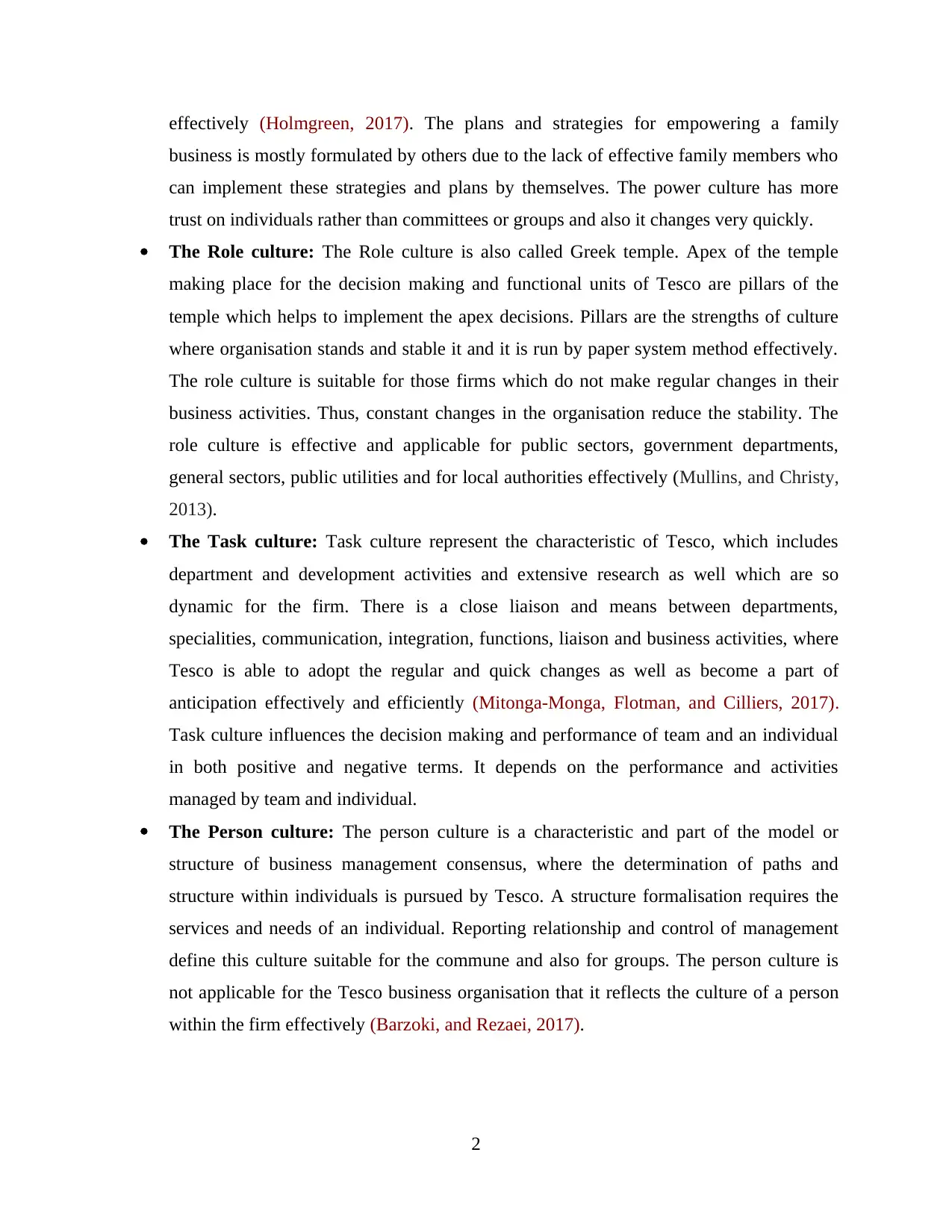
effectively (Holmgreen, 2017). The plans and strategies for empowering a family
business is mostly formulated by others due to the lack of effective family members who
can implement these strategies and plans by themselves. The power culture has more
trust on individuals rather than committees or groups and also it changes very quickly.
The Role culture: The Role culture is also called Greek temple. Apex of the temple
making place for the decision making and functional units of Tesco are pillars of the
temple which helps to implement the apex decisions. Pillars are the strengths of culture
where organisation stands and stable it and it is run by paper system method effectively.
The role culture is suitable for those firms which do not make regular changes in their
business activities. Thus, constant changes in the organisation reduce the stability. The
role culture is effective and applicable for public sectors, government departments,
general sectors, public utilities and for local authorities effectively (Mullins, and Christy,
2013).
The Task culture: Task culture represent the characteristic of Tesco, which includes
department and development activities and extensive research as well which are so
dynamic for the firm. There is a close liaison and means between departments,
specialities, communication, integration, functions, liaison and business activities, where
Tesco is able to adopt the regular and quick changes as well as become a part of
anticipation effectively and efficiently (Mitonga-Monga, Flotman, and Cilliers, 2017).
Task culture influences the decision making and performance of team and an individual
in both positive and negative terms. It depends on the performance and activities
managed by team and individual.
The Person culture: The person culture is a characteristic and part of the model or
structure of business management consensus, where the determination of paths and
structure within individuals is pursued by Tesco. A structure formalisation requires the
services and needs of an individual. Reporting relationship and control of management
define this culture suitable for the commune and also for groups. The person culture is
not applicable for the Tesco business organisation that it reflects the culture of a person
within the firm effectively (Barzoki, and Rezaei, 2017).
2
business is mostly formulated by others due to the lack of effective family members who
can implement these strategies and plans by themselves. The power culture has more
trust on individuals rather than committees or groups and also it changes very quickly.
The Role culture: The Role culture is also called Greek temple. Apex of the temple
making place for the decision making and functional units of Tesco are pillars of the
temple which helps to implement the apex decisions. Pillars are the strengths of culture
where organisation stands and stable it and it is run by paper system method effectively.
The role culture is suitable for those firms which do not make regular changes in their
business activities. Thus, constant changes in the organisation reduce the stability. The
role culture is effective and applicable for public sectors, government departments,
general sectors, public utilities and for local authorities effectively (Mullins, and Christy,
2013).
The Task culture: Task culture represent the characteristic of Tesco, which includes
department and development activities and extensive research as well which are so
dynamic for the firm. There is a close liaison and means between departments,
specialities, communication, integration, functions, liaison and business activities, where
Tesco is able to adopt the regular and quick changes as well as become a part of
anticipation effectively and efficiently (Mitonga-Monga, Flotman, and Cilliers, 2017).
Task culture influences the decision making and performance of team and an individual
in both positive and negative terms. It depends on the performance and activities
managed by team and individual.
The Person culture: The person culture is a characteristic and part of the model or
structure of business management consensus, where the determination of paths and
structure within individuals is pursued by Tesco. A structure formalisation requires the
services and needs of an individual. Reporting relationship and control of management
define this culture suitable for the commune and also for groups. The person culture is
not applicable for the Tesco business organisation that it reflects the culture of a person
within the firm effectively (Barzoki, and Rezaei, 2017).
2
Paraphrase This Document
Need a fresh take? Get an instant paraphrase of this document with our AI Paraphraser
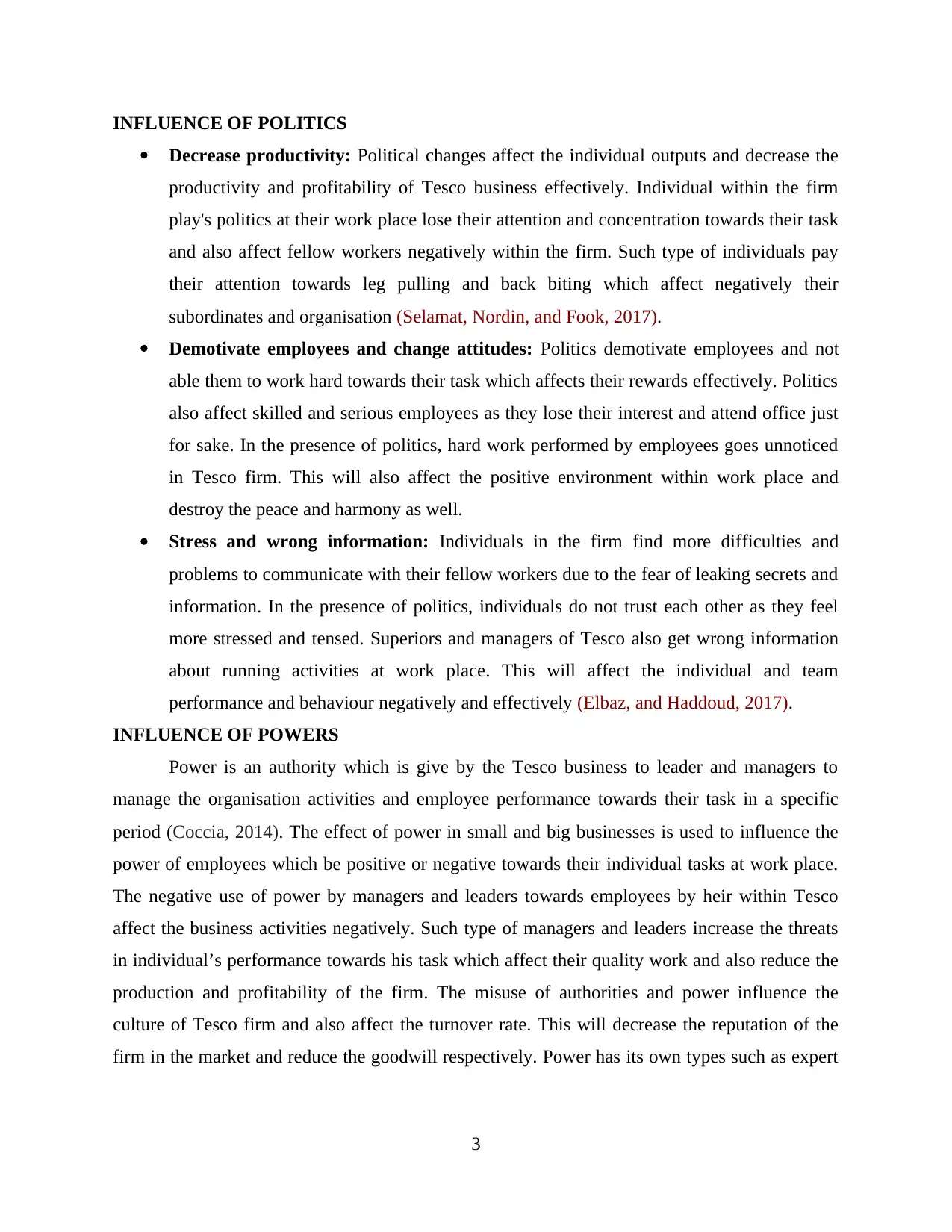
INFLUENCE OF POLITICS
Decrease productivity: Political changes affect the individual outputs and decrease the
productivity and profitability of Tesco business effectively. Individual within the firm
play's politics at their work place lose their attention and concentration towards their task
and also affect fellow workers negatively within the firm. Such type of individuals pay
their attention towards leg pulling and back biting which affect negatively their
subordinates and organisation (Selamat, Nordin, and Fook, 2017).
Demotivate employees and change attitudes: Politics demotivate employees and not
able them to work hard towards their task which affects their rewards effectively. Politics
also affect skilled and serious employees as they lose their interest and attend office just
for sake. In the presence of politics, hard work performed by employees goes unnoticed
in Tesco firm. This will also affect the positive environment within work place and
destroy the peace and harmony as well.
Stress and wrong information: Individuals in the firm find more difficulties and
problems to communicate with their fellow workers due to the fear of leaking secrets and
information. In the presence of politics, individuals do not trust each other as they feel
more stressed and tensed. Superiors and managers of Tesco also get wrong information
about running activities at work place. This will affect the individual and team
performance and behaviour negatively and effectively (Elbaz, and Haddoud, 2017).
INFLUENCE OF POWERS
Power is an authority which is give by the Tesco business to leader and managers to
manage the organisation activities and employee performance towards their task in a specific
period (Coccia, 2014). The effect of power in small and big businesses is used to influence the
power of employees which be positive or negative towards their individual tasks at work place.
The negative use of power by managers and leaders towards employees by heir within Tesco
affect the business activities negatively. Such type of managers and leaders increase the threats
in individual’s performance towards his task which affect their quality work and also reduce the
production and profitability of the firm. The misuse of authorities and power influence the
culture of Tesco firm and also affect the turnover rate. This will decrease the reputation of the
firm in the market and reduce the goodwill respectively. Power has its own types such as expert
3
Decrease productivity: Political changes affect the individual outputs and decrease the
productivity and profitability of Tesco business effectively. Individual within the firm
play's politics at their work place lose their attention and concentration towards their task
and also affect fellow workers negatively within the firm. Such type of individuals pay
their attention towards leg pulling and back biting which affect negatively their
subordinates and organisation (Selamat, Nordin, and Fook, 2017).
Demotivate employees and change attitudes: Politics demotivate employees and not
able them to work hard towards their task which affects their rewards effectively. Politics
also affect skilled and serious employees as they lose their interest and attend office just
for sake. In the presence of politics, hard work performed by employees goes unnoticed
in Tesco firm. This will also affect the positive environment within work place and
destroy the peace and harmony as well.
Stress and wrong information: Individuals in the firm find more difficulties and
problems to communicate with their fellow workers due to the fear of leaking secrets and
information. In the presence of politics, individuals do not trust each other as they feel
more stressed and tensed. Superiors and managers of Tesco also get wrong information
about running activities at work place. This will affect the individual and team
performance and behaviour negatively and effectively (Elbaz, and Haddoud, 2017).
INFLUENCE OF POWERS
Power is an authority which is give by the Tesco business to leader and managers to
manage the organisation activities and employee performance towards their task in a specific
period (Coccia, 2014). The effect of power in small and big businesses is used to influence the
power of employees which be positive or negative towards their individual tasks at work place.
The negative use of power by managers and leaders towards employees by heir within Tesco
affect the business activities negatively. Such type of managers and leaders increase the threats
in individual’s performance towards his task which affect their quality work and also reduce the
production and profitability of the firm. The misuse of authorities and power influence the
culture of Tesco firm and also affect the turnover rate. This will decrease the reputation of the
firm in the market and reduce the goodwill respectively. Power has its own types such as expert
3
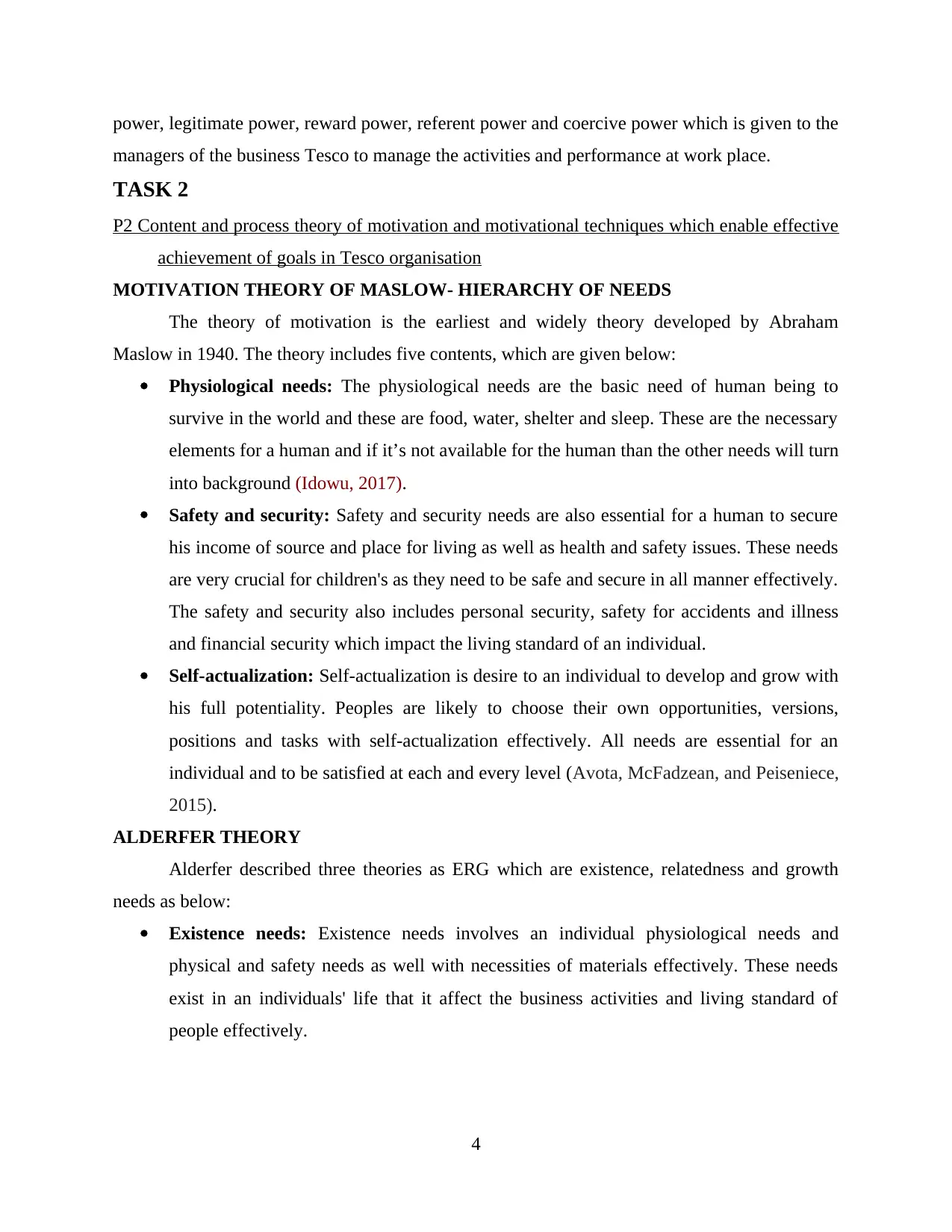
power, legitimate power, reward power, referent power and coercive power which is given to the
managers of the business Tesco to manage the activities and performance at work place.
TASK 2
P2 Content and process theory of motivation and motivational techniques which enable effective
achievement of goals in Tesco organisation
MOTIVATION THEORY OF MASLOW- HIERARCHY OF NEEDS
The theory of motivation is the earliest and widely theory developed by Abraham
Maslow in 1940. The theory includes five contents, which are given below:
Physiological needs: The physiological needs are the basic need of human being to
survive in the world and these are food, water, shelter and sleep. These are the necessary
elements for a human and if it’s not available for the human than the other needs will turn
into background (Idowu, 2017).
Safety and security: Safety and security needs are also essential for a human to secure
his income of source and place for living as well as health and safety issues. These needs
are very crucial for children's as they need to be safe and secure in all manner effectively.
The safety and security also includes personal security, safety for accidents and illness
and financial security which impact the living standard of an individual.
Self-actualization: Self-actualization is desire to an individual to develop and grow with
his full potentiality. Peoples are likely to choose their own opportunities, versions,
positions and tasks with self-actualization effectively. All needs are essential for an
individual and to be satisfied at each and every level (Avota, McFadzean, and Peiseniece,
2015).
ALDERFER THEORY
Alderfer described three theories as ERG which are existence, relatedness and growth
needs as below:
Existence needs: Existence needs involves an individual physiological needs and
physical and safety needs as well with necessities of materials effectively. These needs
exist in an individuals' life that it affect the business activities and living standard of
people effectively.
4
managers of the business Tesco to manage the activities and performance at work place.
TASK 2
P2 Content and process theory of motivation and motivational techniques which enable effective
achievement of goals in Tesco organisation
MOTIVATION THEORY OF MASLOW- HIERARCHY OF NEEDS
The theory of motivation is the earliest and widely theory developed by Abraham
Maslow in 1940. The theory includes five contents, which are given below:
Physiological needs: The physiological needs are the basic need of human being to
survive in the world and these are food, water, shelter and sleep. These are the necessary
elements for a human and if it’s not available for the human than the other needs will turn
into background (Idowu, 2017).
Safety and security: Safety and security needs are also essential for a human to secure
his income of source and place for living as well as health and safety issues. These needs
are very crucial for children's as they need to be safe and secure in all manner effectively.
The safety and security also includes personal security, safety for accidents and illness
and financial security which impact the living standard of an individual.
Self-actualization: Self-actualization is desire to an individual to develop and grow with
his full potentiality. Peoples are likely to choose their own opportunities, versions,
positions and tasks with self-actualization effectively. All needs are essential for an
individual and to be satisfied at each and every level (Avota, McFadzean, and Peiseniece,
2015).
ALDERFER THEORY
Alderfer described three theories as ERG which are existence, relatedness and growth
needs as below:
Existence needs: Existence needs involves an individual physiological needs and
physical and safety needs as well with necessities of materials effectively. These needs
exist in an individuals' life that it affect the business activities and living standard of
people effectively.
4
⊘ This is a preview!⊘
Do you want full access?
Subscribe today to unlock all pages.

Trusted by 1+ million students worldwide
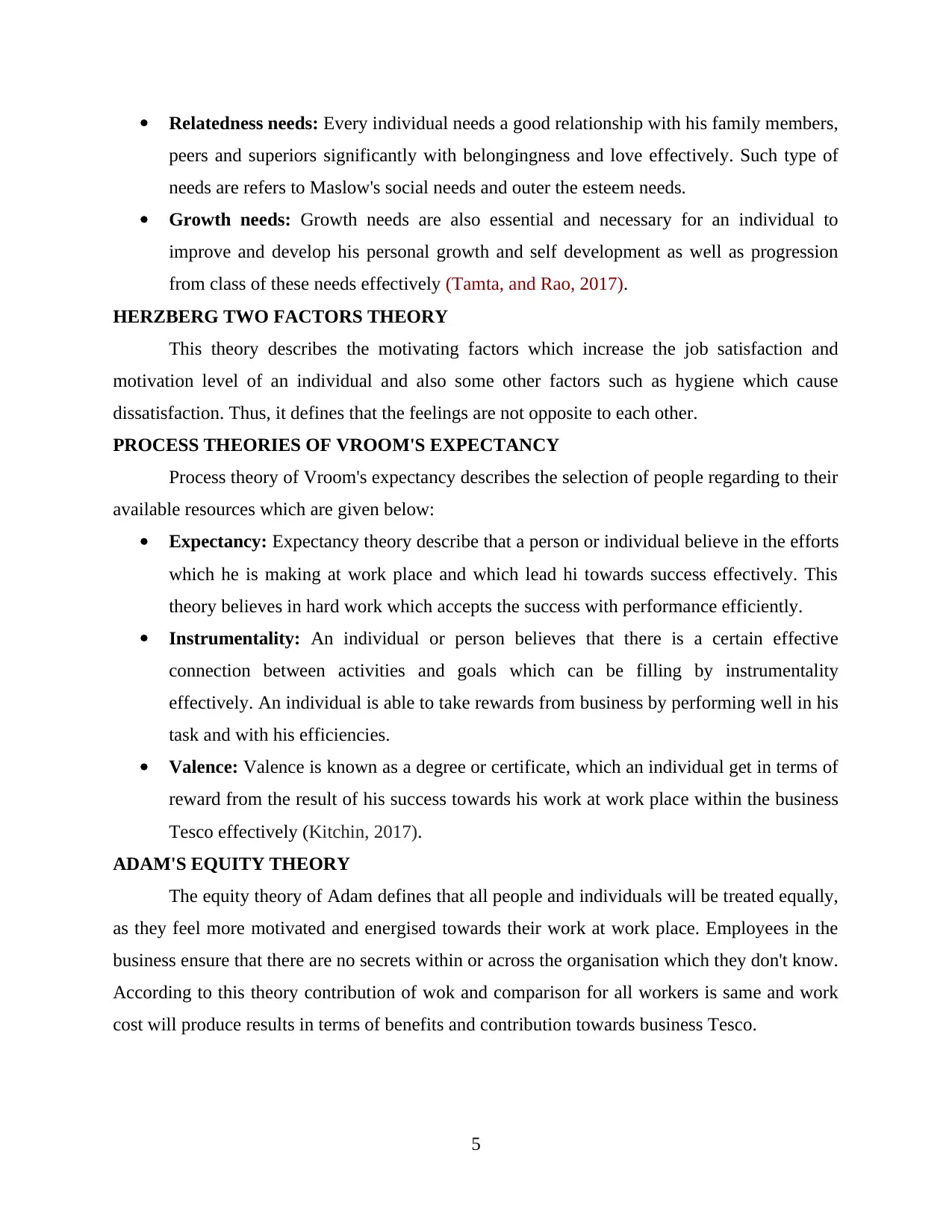
Relatedness needs: Every individual needs a good relationship with his family members,
peers and superiors significantly with belongingness and love effectively. Such type of
needs are refers to Maslow's social needs and outer the esteem needs.
Growth needs: Growth needs are also essential and necessary for an individual to
improve and develop his personal growth and self development as well as progression
from class of these needs effectively (Tamta, and Rao, 2017).
HERZBERG TWO FACTORS THEORY
This theory describes the motivating factors which increase the job satisfaction and
motivation level of an individual and also some other factors such as hygiene which cause
dissatisfaction. Thus, it defines that the feelings are not opposite to each other.
PROCESS THEORIES OF VROOM'S EXPECTANCY
Process theory of Vroom's expectancy describes the selection of people regarding to their
available resources which are given below:
Expectancy: Expectancy theory describe that a person or individual believe in the efforts
which he is making at work place and which lead hi towards success effectively. This
theory believes in hard work which accepts the success with performance efficiently.
Instrumentality: An individual or person believes that there is a certain effective
connection between activities and goals which can be filling by instrumentality
effectively. An individual is able to take rewards from business by performing well in his
task and with his efficiencies.
Valence: Valence is known as a degree or certificate, which an individual get in terms of
reward from the result of his success towards his work at work place within the business
Tesco effectively (Kitchin, 2017).
ADAM'S EQUITY THEORY
The equity theory of Adam defines that all people and individuals will be treated equally,
as they feel more motivated and energised towards their work at work place. Employees in the
business ensure that there are no secrets within or across the organisation which they don't know.
According to this theory contribution of wok and comparison for all workers is same and work
cost will produce results in terms of benefits and contribution towards business Tesco.
5
peers and superiors significantly with belongingness and love effectively. Such type of
needs are refers to Maslow's social needs and outer the esteem needs.
Growth needs: Growth needs are also essential and necessary for an individual to
improve and develop his personal growth and self development as well as progression
from class of these needs effectively (Tamta, and Rao, 2017).
HERZBERG TWO FACTORS THEORY
This theory describes the motivating factors which increase the job satisfaction and
motivation level of an individual and also some other factors such as hygiene which cause
dissatisfaction. Thus, it defines that the feelings are not opposite to each other.
PROCESS THEORIES OF VROOM'S EXPECTANCY
Process theory of Vroom's expectancy describes the selection of people regarding to their
available resources which are given below:
Expectancy: Expectancy theory describe that a person or individual believe in the efforts
which he is making at work place and which lead hi towards success effectively. This
theory believes in hard work which accepts the success with performance efficiently.
Instrumentality: An individual or person believes that there is a certain effective
connection between activities and goals which can be filling by instrumentality
effectively. An individual is able to take rewards from business by performing well in his
task and with his efficiencies.
Valence: Valence is known as a degree or certificate, which an individual get in terms of
reward from the result of his success towards his work at work place within the business
Tesco effectively (Kitchin, 2017).
ADAM'S EQUITY THEORY
The equity theory of Adam defines that all people and individuals will be treated equally,
as they feel more motivated and energised towards their work at work place. Employees in the
business ensure that there are no secrets within or across the organisation which they don't know.
According to this theory contribution of wok and comparison for all workers is same and work
cost will produce results in terms of benefits and contribution towards business Tesco.
5
Paraphrase This Document
Need a fresh take? Get an instant paraphrase of this document with our AI Paraphraser
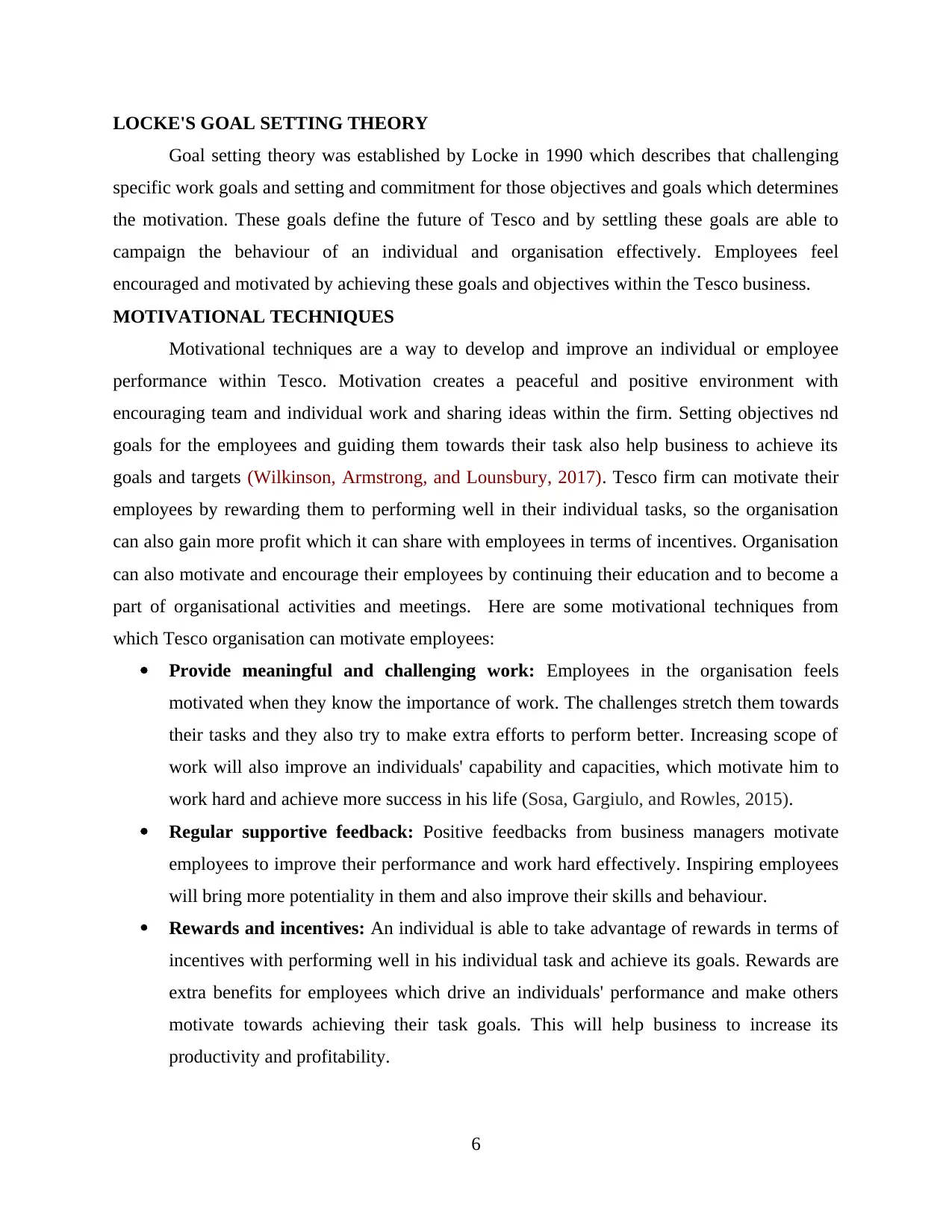
LOCKE'S GOAL SETTING THEORY
Goal setting theory was established by Locke in 1990 which describes that challenging
specific work goals and setting and commitment for those objectives and goals which determines
the motivation. These goals define the future of Tesco and by settling these goals are able to
campaign the behaviour of an individual and organisation effectively. Employees feel
encouraged and motivated by achieving these goals and objectives within the Tesco business.
MOTIVATIONAL TECHNIQUES
Motivational techniques are a way to develop and improve an individual or employee
performance within Tesco. Motivation creates a peaceful and positive environment with
encouraging team and individual work and sharing ideas within the firm. Setting objectives nd
goals for the employees and guiding them towards their task also help business to achieve its
goals and targets (Wilkinson, Armstrong, and Lounsbury, 2017). Tesco firm can motivate their
employees by rewarding them to performing well in their individual tasks, so the organisation
can also gain more profit which it can share with employees in terms of incentives. Organisation
can also motivate and encourage their employees by continuing their education and to become a
part of organisational activities and meetings. Here are some motivational techniques from
which Tesco organisation can motivate employees:
Provide meaningful and challenging work: Employees in the organisation feels
motivated when they know the importance of work. The challenges stretch them towards
their tasks and they also try to make extra efforts to perform better. Increasing scope of
work will also improve an individuals' capability and capacities, which motivate him to
work hard and achieve more success in his life (Sosa, Gargiulo, and Rowles, 2015).
Regular supportive feedback: Positive feedbacks from business managers motivate
employees to improve their performance and work hard effectively. Inspiring employees
will bring more potentiality in them and also improve their skills and behaviour.
Rewards and incentives: An individual is able to take advantage of rewards in terms of
incentives with performing well in his individual task and achieve its goals. Rewards are
extra benefits for employees which drive an individuals' performance and make others
motivate towards achieving their task goals. This will help business to increase its
productivity and profitability.
6
Goal setting theory was established by Locke in 1990 which describes that challenging
specific work goals and setting and commitment for those objectives and goals which determines
the motivation. These goals define the future of Tesco and by settling these goals are able to
campaign the behaviour of an individual and organisation effectively. Employees feel
encouraged and motivated by achieving these goals and objectives within the Tesco business.
MOTIVATIONAL TECHNIQUES
Motivational techniques are a way to develop and improve an individual or employee
performance within Tesco. Motivation creates a peaceful and positive environment with
encouraging team and individual work and sharing ideas within the firm. Setting objectives nd
goals for the employees and guiding them towards their task also help business to achieve its
goals and targets (Wilkinson, Armstrong, and Lounsbury, 2017). Tesco firm can motivate their
employees by rewarding them to performing well in their individual tasks, so the organisation
can also gain more profit which it can share with employees in terms of incentives. Organisation
can also motivate and encourage their employees by continuing their education and to become a
part of organisational activities and meetings. Here are some motivational techniques from
which Tesco organisation can motivate employees:
Provide meaningful and challenging work: Employees in the organisation feels
motivated when they know the importance of work. The challenges stretch them towards
their tasks and they also try to make extra efforts to perform better. Increasing scope of
work will also improve an individuals' capability and capacities, which motivate him to
work hard and achieve more success in his life (Sosa, Gargiulo, and Rowles, 2015).
Regular supportive feedback: Positive feedbacks from business managers motivate
employees to improve their performance and work hard effectively. Inspiring employees
will bring more potentiality in them and also improve their skills and behaviour.
Rewards and incentives: An individual is able to take advantage of rewards in terms of
incentives with performing well in his individual task and achieve its goals. Rewards are
extra benefits for employees which drive an individuals' performance and make others
motivate towards achieving their task goals. This will help business to increase its
productivity and profitability.
6
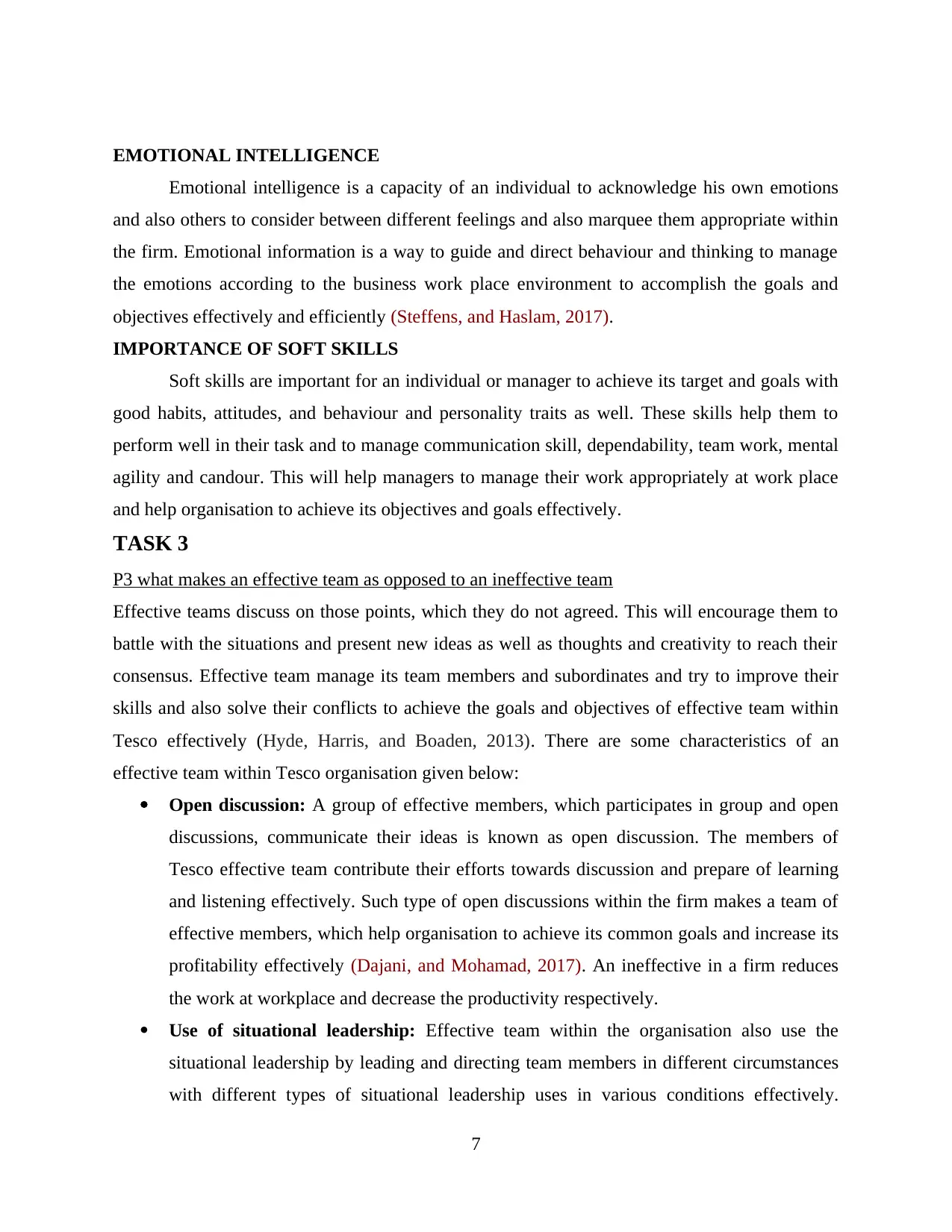
EMOTIONAL INTELLIGENCE
Emotional intelligence is a capacity of an individual to acknowledge his own emotions
and also others to consider between different feelings and also marquee them appropriate within
the firm. Emotional information is a way to guide and direct behaviour and thinking to manage
the emotions according to the business work place environment to accomplish the goals and
objectives effectively and efficiently (Steffens, and Haslam, 2017).
IMPORTANCE OF SOFT SKILLS
Soft skills are important for an individual or manager to achieve its target and goals with
good habits, attitudes, and behaviour and personality traits as well. These skills help them to
perform well in their task and to manage communication skill, dependability, team work, mental
agility and candour. This will help managers to manage their work appropriately at work place
and help organisation to achieve its objectives and goals effectively.
TASK 3
P3 what makes an effective team as opposed to an ineffective team
Effective teams discuss on those points, which they do not agreed. This will encourage them to
battle with the situations and present new ideas as well as thoughts and creativity to reach their
consensus. Effective team manage its team members and subordinates and try to improve their
skills and also solve their conflicts to achieve the goals and objectives of effective team within
Tesco effectively (Hyde, Harris, and Boaden, 2013). There are some characteristics of an
effective team within Tesco organisation given below:
Open discussion: A group of effective members, which participates in group and open
discussions, communicate their ideas is known as open discussion. The members of
Tesco effective team contribute their efforts towards discussion and prepare of learning
and listening effectively. Such type of open discussions within the firm makes a team of
effective members, which help organisation to achieve its common goals and increase its
profitability effectively (Dajani, and Mohamad, 2017). An ineffective in a firm reduces
the work at workplace and decrease the productivity respectively.
Use of situational leadership: Effective team within the organisation also use the
situational leadership by leading and directing team members in different circumstances
with different types of situational leadership uses in various conditions effectively.
7
Emotional intelligence is a capacity of an individual to acknowledge his own emotions
and also others to consider between different feelings and also marquee them appropriate within
the firm. Emotional information is a way to guide and direct behaviour and thinking to manage
the emotions according to the business work place environment to accomplish the goals and
objectives effectively and efficiently (Steffens, and Haslam, 2017).
IMPORTANCE OF SOFT SKILLS
Soft skills are important for an individual or manager to achieve its target and goals with
good habits, attitudes, and behaviour and personality traits as well. These skills help them to
perform well in their task and to manage communication skill, dependability, team work, mental
agility and candour. This will help managers to manage their work appropriately at work place
and help organisation to achieve its objectives and goals effectively.
TASK 3
P3 what makes an effective team as opposed to an ineffective team
Effective teams discuss on those points, which they do not agreed. This will encourage them to
battle with the situations and present new ideas as well as thoughts and creativity to reach their
consensus. Effective team manage its team members and subordinates and try to improve their
skills and also solve their conflicts to achieve the goals and objectives of effective team within
Tesco effectively (Hyde, Harris, and Boaden, 2013). There are some characteristics of an
effective team within Tesco organisation given below:
Open discussion: A group of effective members, which participates in group and open
discussions, communicate their ideas is known as open discussion. The members of
Tesco effective team contribute their efforts towards discussion and prepare of learning
and listening effectively. Such type of open discussions within the firm makes a team of
effective members, which help organisation to achieve its common goals and increase its
profitability effectively (Dajani, and Mohamad, 2017). An ineffective in a firm reduces
the work at workplace and decrease the productivity respectively.
Use of situational leadership: Effective team within the organisation also use the
situational leadership by leading and directing team members in different circumstances
with different types of situational leadership uses in various conditions effectively.
7
⊘ This is a preview!⊘
Do you want full access?
Subscribe today to unlock all pages.

Trusted by 1+ million students worldwide
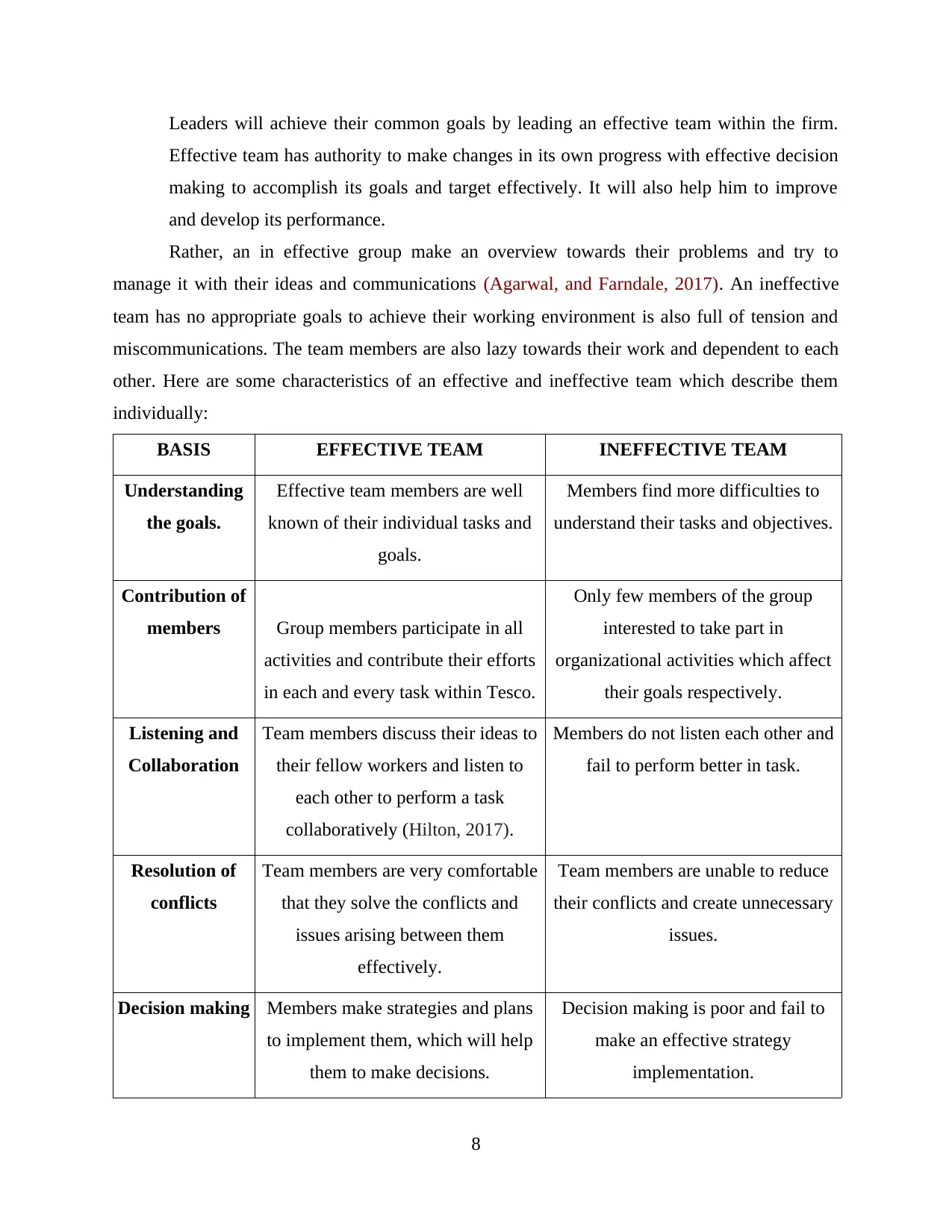
Leaders will achieve their common goals by leading an effective team within the firm.
Effective team has authority to make changes in its own progress with effective decision
making to accomplish its goals and target effectively. It will also help him to improve
and develop its performance.
Rather, an in effective group make an overview towards their problems and try to
manage it with their ideas and communications (Agarwal, and Farndale, 2017). An ineffective
team has no appropriate goals to achieve their working environment is also full of tension and
miscommunications. The team members are also lazy towards their work and dependent to each
other. Here are some characteristics of an effective and ineffective team which describe them
individually:
BASIS EFFECTIVE TEAM INEFFECTIVE TEAM
Understanding
the goals.
Effective team members are well
known of their individual tasks and
goals.
Members find more difficulties to
understand their tasks and objectives.
Contribution of
members Group members participate in all
activities and contribute their efforts
in each and every task within Tesco.
Only few members of the group
interested to take part in
organizational activities which affect
their goals respectively.
Listening and
Collaboration
Team members discuss their ideas to
their fellow workers and listen to
each other to perform a task
collaboratively (Hilton, 2017).
Members do not listen each other and
fail to perform better in task.
Resolution of
conflicts
Team members are very comfortable
that they solve the conflicts and
issues arising between them
effectively.
Team members are unable to reduce
their conflicts and create unnecessary
issues.
Decision making Members make strategies and plans
to implement them, which will help
them to make decisions.
Decision making is poor and fail to
make an effective strategy
implementation.
8
Effective team has authority to make changes in its own progress with effective decision
making to accomplish its goals and target effectively. It will also help him to improve
and develop its performance.
Rather, an in effective group make an overview towards their problems and try to
manage it with their ideas and communications (Agarwal, and Farndale, 2017). An ineffective
team has no appropriate goals to achieve their working environment is also full of tension and
miscommunications. The team members are also lazy towards their work and dependent to each
other. Here are some characteristics of an effective and ineffective team which describe them
individually:
BASIS EFFECTIVE TEAM INEFFECTIVE TEAM
Understanding
the goals.
Effective team members are well
known of their individual tasks and
goals.
Members find more difficulties to
understand their tasks and objectives.
Contribution of
members Group members participate in all
activities and contribute their efforts
in each and every task within Tesco.
Only few members of the group
interested to take part in
organizational activities which affect
their goals respectively.
Listening and
Collaboration
Team members discuss their ideas to
their fellow workers and listen to
each other to perform a task
collaboratively (Hilton, 2017).
Members do not listen each other and
fail to perform better in task.
Resolution of
conflicts
Team members are very comfortable
that they solve the conflicts and
issues arising between them
effectively.
Team members are unable to reduce
their conflicts and create unnecessary
issues.
Decision making Members make strategies and plans
to implement them, which will help
them to make decisions.
Decision making is poor and fail to
make an effective strategy
implementation.
8
Paraphrase This Document
Need a fresh take? Get an instant paraphrase of this document with our AI Paraphraser
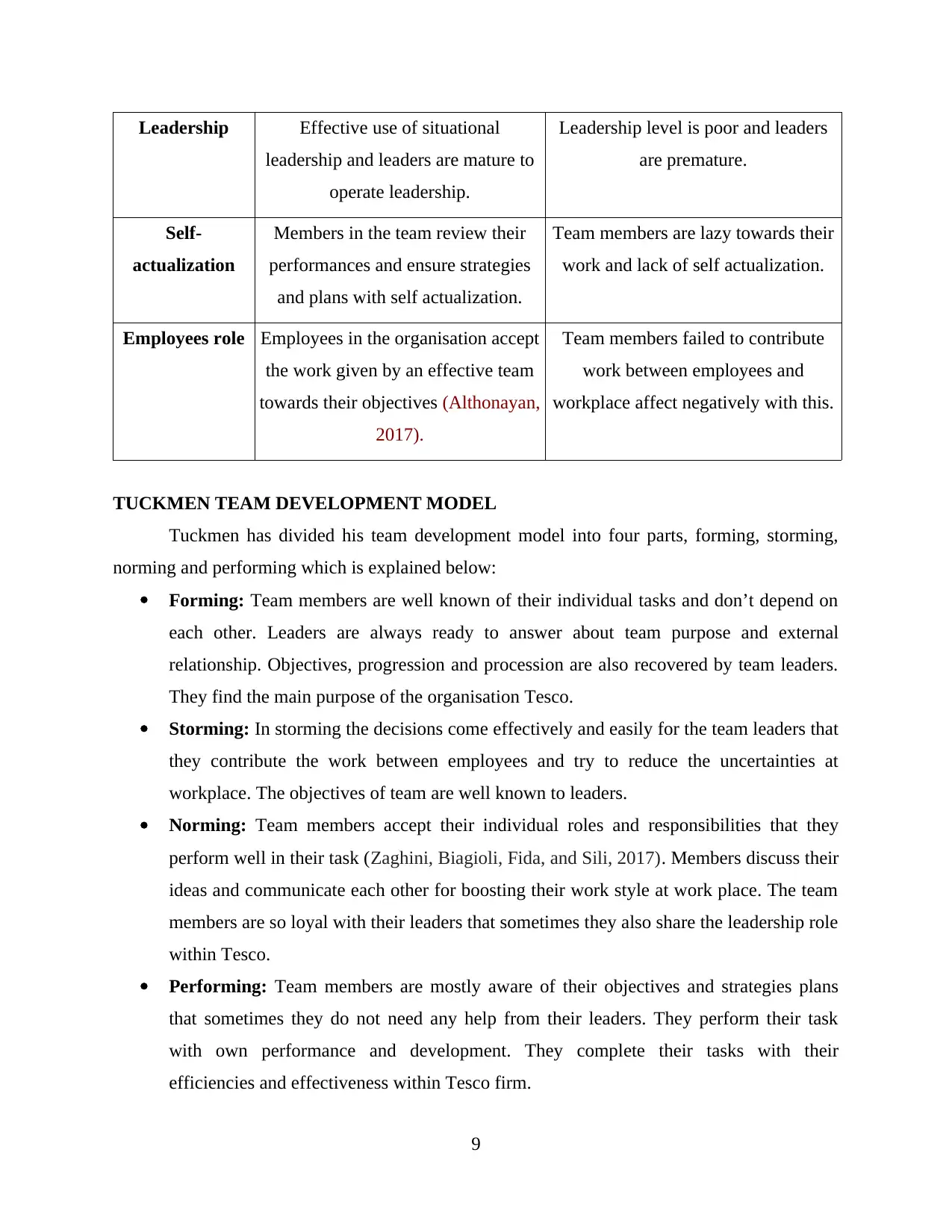
Leadership Effective use of situational
leadership and leaders are mature to
operate leadership.
Leadership level is poor and leaders
are premature.
Self-
actualization
Members in the team review their
performances and ensure strategies
and plans with self actualization.
Team members are lazy towards their
work and lack of self actualization.
Employees role Employees in the organisation accept
the work given by an effective team
towards their objectives (Althonayan,
2017).
Team members failed to contribute
work between employees and
workplace affect negatively with this.
TUCKMEN TEAM DEVELOPMENT MODEL
Tuckmen has divided his team development model into four parts, forming, storming,
norming and performing which is explained below:
Forming: Team members are well known of their individual tasks and don’t depend on
each other. Leaders are always ready to answer about team purpose and external
relationship. Objectives, progression and procession are also recovered by team leaders.
They find the main purpose of the organisation Tesco.
Storming: In storming the decisions come effectively and easily for the team leaders that
they contribute the work between employees and try to reduce the uncertainties at
workplace. The objectives of team are well known to leaders.
Norming: Team members accept their individual roles and responsibilities that they
perform well in their task (Zaghini, Biagioli, Fida, and Sili, 2017). Members discuss their
ideas and communicate each other for boosting their work style at work place. The team
members are so loyal with their leaders that sometimes they also share the leadership role
within Tesco.
Performing: Team members are mostly aware of their objectives and strategies plans
that sometimes they do not need any help from their leaders. They perform their task
with own performance and development. They complete their tasks with their
efficiencies and effectiveness within Tesco firm.
9
leadership and leaders are mature to
operate leadership.
Leadership level is poor and leaders
are premature.
Self-
actualization
Members in the team review their
performances and ensure strategies
and plans with self actualization.
Team members are lazy towards their
work and lack of self actualization.
Employees role Employees in the organisation accept
the work given by an effective team
towards their objectives (Althonayan,
2017).
Team members failed to contribute
work between employees and
workplace affect negatively with this.
TUCKMEN TEAM DEVELOPMENT MODEL
Tuckmen has divided his team development model into four parts, forming, storming,
norming and performing which is explained below:
Forming: Team members are well known of their individual tasks and don’t depend on
each other. Leaders are always ready to answer about team purpose and external
relationship. Objectives, progression and procession are also recovered by team leaders.
They find the main purpose of the organisation Tesco.
Storming: In storming the decisions come effectively and easily for the team leaders that
they contribute the work between employees and try to reduce the uncertainties at
workplace. The objectives of team are well known to leaders.
Norming: Team members accept their individual roles and responsibilities that they
perform well in their task (Zaghini, Biagioli, Fida, and Sili, 2017). Members discuss their
ideas and communicate each other for boosting their work style at work place. The team
members are so loyal with their leaders that sometimes they also share the leadership role
within Tesco.
Performing: Team members are mostly aware of their objectives and strategies plans
that sometimes they do not need any help from their leaders. They perform their task
with own performance and development. They complete their tasks with their
efficiencies and effectiveness within Tesco firm.
9
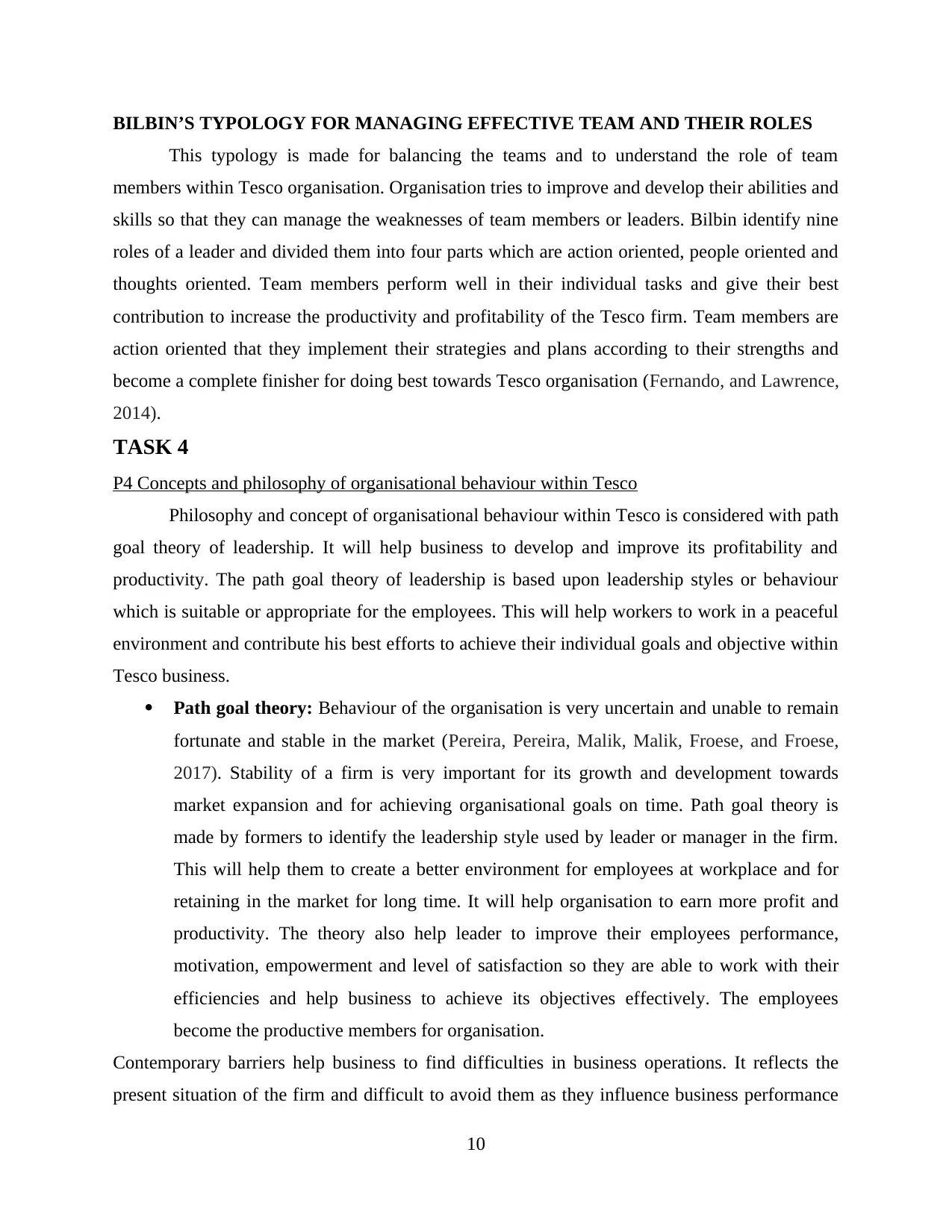
BILBIN’S TYPOLOGY FOR MANAGING EFFECTIVE TEAM AND THEIR ROLES
This typology is made for balancing the teams and to understand the role of team
members within Tesco organisation. Organisation tries to improve and develop their abilities and
skills so that they can manage the weaknesses of team members or leaders. Bilbin identify nine
roles of a leader and divided them into four parts which are action oriented, people oriented and
thoughts oriented. Team members perform well in their individual tasks and give their best
contribution to increase the productivity and profitability of the Tesco firm. Team members are
action oriented that they implement their strategies and plans according to their strengths and
become a complete finisher for doing best towards Tesco organisation (Fernando, and Lawrence,
2014).
TASK 4
P4 Concepts and philosophy of organisational behaviour within Tesco
Philosophy and concept of organisational behaviour within Tesco is considered with path
goal theory of leadership. It will help business to develop and improve its profitability and
productivity. The path goal theory of leadership is based upon leadership styles or behaviour
which is suitable or appropriate for the employees. This will help workers to work in a peaceful
environment and contribute his best efforts to achieve their individual goals and objective within
Tesco business.
Path goal theory: Behaviour of the organisation is very uncertain and unable to remain
fortunate and stable in the market (Pereira, Pereira, Malik, Malik, Froese, and Froese,
2017). Stability of a firm is very important for its growth and development towards
market expansion and for achieving organisational goals on time. Path goal theory is
made by formers to identify the leadership style used by leader or manager in the firm.
This will help them to create a better environment for employees at workplace and for
retaining in the market for long time. It will help organisation to earn more profit and
productivity. The theory also help leader to improve their employees performance,
motivation, empowerment and level of satisfaction so they are able to work with their
efficiencies and help business to achieve its objectives effectively. The employees
become the productive members for organisation.
Contemporary barriers help business to find difficulties in business operations. It reflects the
present situation of the firm and difficult to avoid them as they influence business performance
10
This typology is made for balancing the teams and to understand the role of team
members within Tesco organisation. Organisation tries to improve and develop their abilities and
skills so that they can manage the weaknesses of team members or leaders. Bilbin identify nine
roles of a leader and divided them into four parts which are action oriented, people oriented and
thoughts oriented. Team members perform well in their individual tasks and give their best
contribution to increase the productivity and profitability of the Tesco firm. Team members are
action oriented that they implement their strategies and plans according to their strengths and
become a complete finisher for doing best towards Tesco organisation (Fernando, and Lawrence,
2014).
TASK 4
P4 Concepts and philosophy of organisational behaviour within Tesco
Philosophy and concept of organisational behaviour within Tesco is considered with path
goal theory of leadership. It will help business to develop and improve its profitability and
productivity. The path goal theory of leadership is based upon leadership styles or behaviour
which is suitable or appropriate for the employees. This will help workers to work in a peaceful
environment and contribute his best efforts to achieve their individual goals and objective within
Tesco business.
Path goal theory: Behaviour of the organisation is very uncertain and unable to remain
fortunate and stable in the market (Pereira, Pereira, Malik, Malik, Froese, and Froese,
2017). Stability of a firm is very important for its growth and development towards
market expansion and for achieving organisational goals on time. Path goal theory is
made by formers to identify the leadership style used by leader or manager in the firm.
This will help them to create a better environment for employees at workplace and for
retaining in the market for long time. It will help organisation to earn more profit and
productivity. The theory also help leader to improve their employees performance,
motivation, empowerment and level of satisfaction so they are able to work with their
efficiencies and help business to achieve its objectives effectively. The employees
become the productive members for organisation.
Contemporary barriers help business to find difficulties in business operations. It reflects the
present situation of the firm and difficult to avoid them as they influence business performance
10
⊘ This is a preview!⊘
Do you want full access?
Subscribe today to unlock all pages.

Trusted by 1+ million students worldwide
1 out of 18
Related Documents
Your All-in-One AI-Powered Toolkit for Academic Success.
+13062052269
info@desklib.com
Available 24*7 on WhatsApp / Email
![[object Object]](/_next/static/media/star-bottom.7253800d.svg)
Unlock your academic potential
Copyright © 2020–2025 A2Z Services. All Rights Reserved. Developed and managed by ZUCOL.




